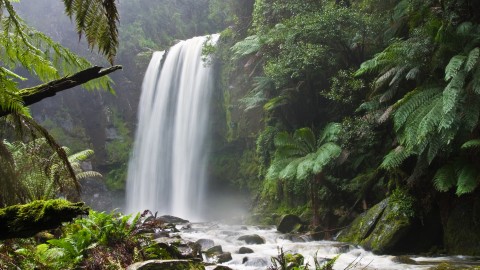SAMYAMA IS TO BE EMPLOYED IN STAGES.
Patanjali is not for sudden enlightenment: and sudden enlightenment is not for everybody. It is rare, it is exceptional; and Patanjali has a very scientific outlook; he does not bother for the exceptional. He discovers the rule, and the exceptional simply proves the rule, nothing else. And the exceptional can take care of itself: there is no need to think about it. The ordinary, the ordinary human being, grows only in stages, step by step, because for a sudden enlightenment, tremendous courage is needed, which is not available.
And, for a sudden enlightenment, there is such a risk in it – one can go mad or one can become enlightened. Both the possibilities remain open because it is so sudden that the mechanism of your body and mind is not ready for it. It can shatter you completely.
Patanjali does not talk about it. In fact he insists that the samyama should be attained in stages so that by and by you move, in small doses you grow, and before you take another step you have become ready and prepared for it.
Enlightenment, for Patanjali, does not take you unawares. Because it is such a tremendous event, you may be so shocked – shocked to death or shocked to madness – he simply debars any talk about it. He does not pay any attention to it.
That is the difference between Patanjali and Zen. Zen is for the exceptional: Patanjali is the rule. If Zen disappears from the world, nothing will be lost because that; exceptional can always take care of itself. But if Patanjali disappears from the world, much will be lost because he is the rule. He is simply for the common, ordinary human being – for all. A Tilopa may take the jump, or a Bodhidharma may take a jump, and disappear. These are adventurers, people who enjoy risk, but that is not the way of everybody. You need a staircase to go up and to go down: you simply don’t jump out of the balconies. And there is no need to take that risk while one can move gracefully.
Zen is a little eccentric because the whole point is of the unique experience. The whole point is of the exceptional, the rare: in a way, the non ordinary. Patanjali, in that way, moves on plain ground. For the common humanity he is a great help.
He says, “samyama is to be employed in stages.” Don’t be in a hurry, move slowly, grow slowly, so everything becomes solid before you take another step.
After each growth, let there be an interval. In that interval, whatsoever you have attained is absorbed, digested, becomes part of your being… then go ahead.
There is no need to run because in running you can come to a point for which you are not ready, and if you are not ready, it is dangerous.
The greedy mind would like to attain everything now. People go to Osho and they say, “Why don’t you give us something which can make us suddenly enlightened?” But these are exactly the people who are not ready. If they were ready they would have patience. If they were ready they would say, “Whenever it comes. We are not in a hurry: we can wait.” They are not the real people: they are greedy people. In fact, they don’t know what they are asking. They are inviting the sky. You will burst: you won’t be able to contain it.
Patanjali says, “samyama is to be employed in stages,” and these eight stages he has described.
THESE THREE – DHARANA, DHYAN, AND SAMADHI – ARE INTERNAL COMPARED TO THE FIVE THAT PRECEDE THEM.
In my blog – Yoga Sutra 31 Samyama – I have written in detail regarding DHARANA, DHYAN, AND SAMADHI.
These three are internal compared to the five that have preceded them…
BUT THE THREE ARE EXTERNAL COMPARED TO SEEDLESS SAMADHI.
If you compare them with yam, niyam, asan, pranayam, pratyahara, then they are internal, but if you compare with the experience, the ultimate experience of a Buddha or Patanjali, they are yet external. They are just in between. First you transcend the body, those are the external steps: then you transcend the mind, these are internal steps: but when you reach your being, even that which was internal now will look external. Even that was not internal enough. Your mind is not internal enough. It is more internal than the body. It is external if you become a witness: then you can watch your own thoughts. When you can watch your own thoughts. Your thoughts become external. They become objects: you are the watcher.
The seedless samadhi means: when there is going to be no birth anymore, when there is going to be no coming back to the world anymore, when there is going to be no entry again in time. The seedless means: the seed of desire is burned completely.
When you move, even towards yoga, when you start the journey inwards, that too is still a desire – desire to achieve oneself, desire to achieve peace, bliss, desire to achieve truth. It is still a desire. When you attain the first samadhi…. After dharana, concentration: dhyan, contemplation: when you come to samadhi, where subject and object become one, even there, a slight shadow of desire is present – the desire to know the truth, the desire to become one, the desire to know God – or whatsoever you name it. Still that desire, very subtle, almost invisible, almost as if it is not: but still it is there. It has to be there because you have been using it all throughout the way. Now that desire also has to be dropped.
Samadhi has also to be dropped. Meditation becomes complete when meditation has to be dropped… when meditation can be dropped. When you forget all about meditation and you drop it, when there is no need to meditate, when there is no need to go anywhere – neither outside nor inside – when all journeying stops, then desire disappears.
Desire is the seed. First it moves you outwards: then, if you are intelligent enough to understand that you are moving in a wrong direction, it starts moving you inwards: but the desire is still there. The same desire, feeling frustrated outside, starts searching inside. That desire has to be dropped.
After samadhi, even samadhi has to be dropped. Then the seedless samadhi arises. That is the ultimate. It arises not because you desired it, because if you desire then it will not be seedless. That has to be understood. It arises only because understanding the futility of desire itself – even the desire to go in the very understanding of the futility of desire, desire disappears. You cannot desire the seedless samadhi. When desire disappears, suddenly, the seedless samadhi is there. It has nothing to do with your effort. This is – the happening.
Up to now, up to samadhi, there is effort: because effort needs desire, motivation.
When desire disappears, effort also disappears. When desire disappears there is no motivation to do anything – neither is there any motivation to do nor is there any motivation to be anything. Total emptiness, nothingness, what Buddha calls shoonya, arises – on its own accord. And that’s the beauty of it untouched by your desire, uncorrupted by your motivation, it is purity itself, it is innocence itself. This is seedless samadhi.
Now there will no longer be any birth. Buddha used to tell his disciples, “When you come to samadhi become alert. Cling to samadhi so that you can be a help to people.” Because if you don’t cling to samadhi, and the seedless samadhi appears, you are gone, gone forever gate, gate, para gate – Gone, gone, gone forever. Then you cannot help. You must have heard the word “bodhisattva.” Bodhisattva means one who has come to samadhi and is denying seedless samadhi, is clinging to samadhi because while he clings to samadhi he can help people, he can still be there, at least one chain with the world is still there.
There is a story that Buddha comes to the ultimate heaven, doors open, and he is invited, but he stands outside. The devas tell him, “Come in. We have been waiting so long for you.” But he says, “How can I come in right now? There are many who need me. I will stand at the door and help to show people the door. I will be the last to enter. When everybody has entered the door, when there is nobody else left outside, then I will enter. If I enter right now, with my entry the door will be lost again: and there are millions who are struggling. They are just coming closer and closer. I will stand outside: I am not going to enter: because you will have to keep the door open while I stand here. You will have to wait for me, and while you are waiting the door will be there, open, and I can show people this is the door.”
This is the state of bodhisattva. Bodhisattva means one who has already come to the door of being a Buddha. In essence he is ready to disappear into the whole, but he resists for compassion. He clings to it. The last desire, to help people – that too is a desire – keeps him in existence. It is very difficult, it is almost impossible, when all the chains are broken from the world, just to depend on a very fragile relationship of compassion – almost impossible. But those are the few moments – when somebody comes to the state of bodhisattva and stays there those are the few moments when the door is open for the whole of humanity, to look at the door, to realize the door, to recognize, and to enter it.
These three – dharana, dhyan, samadhi – are internal compared to the five that preceded them, but the three are external compared to seedless samadhi.
Tags: Patanjali Yoga Sutra 32 Desire Is The Seed










